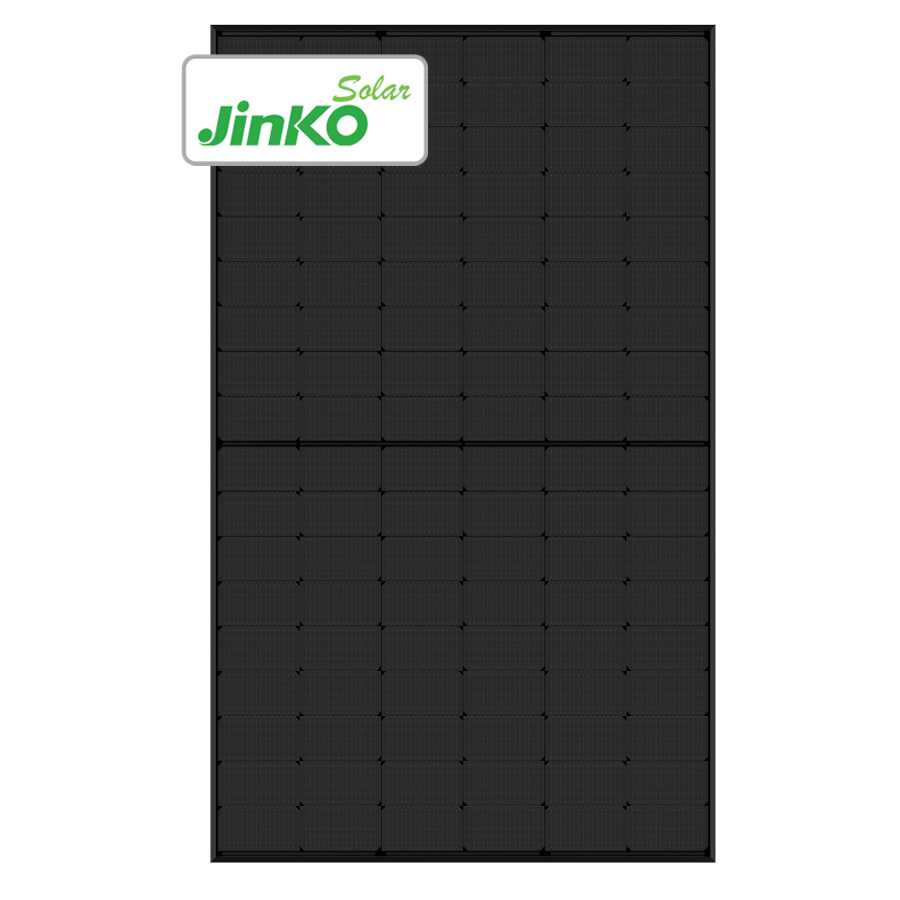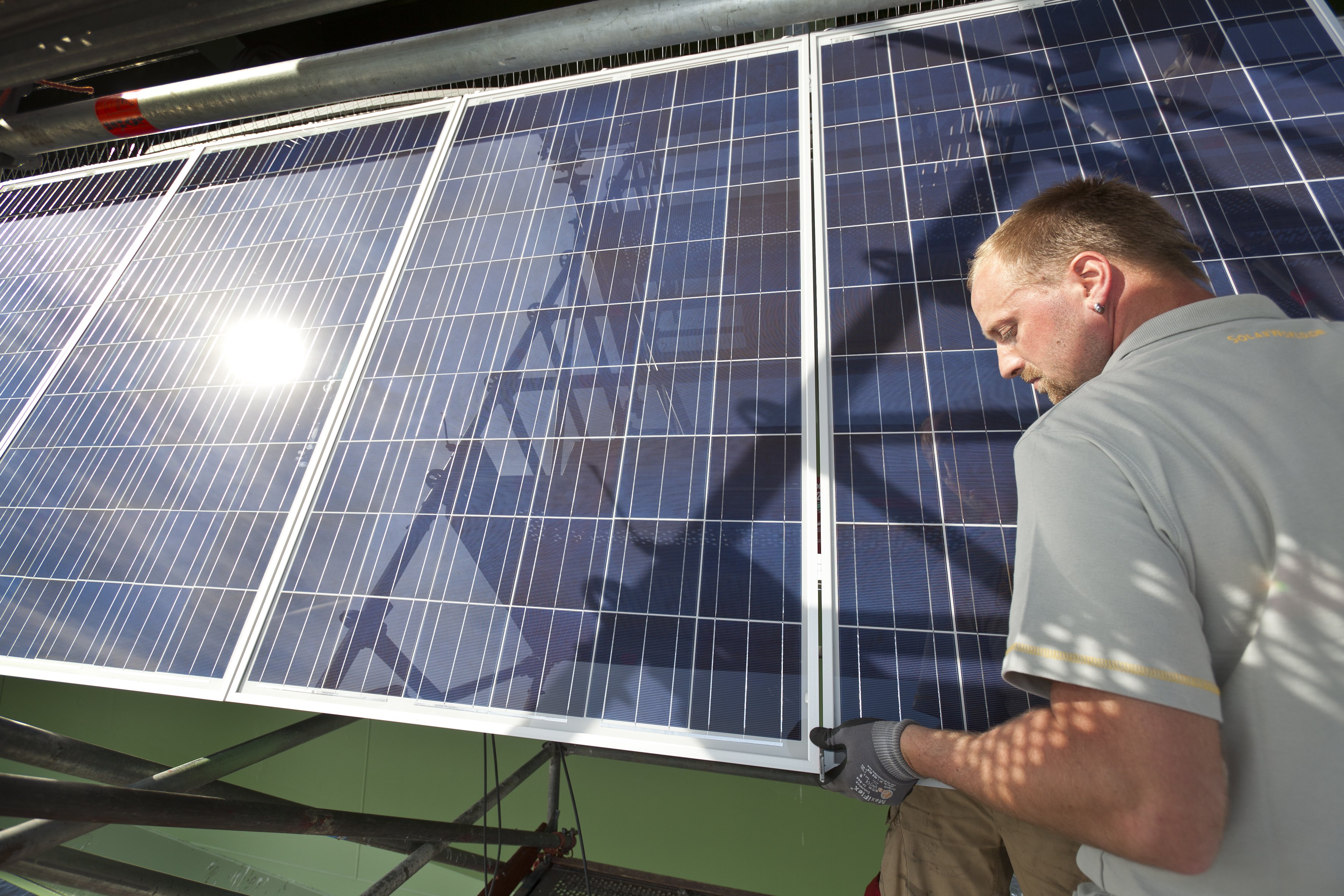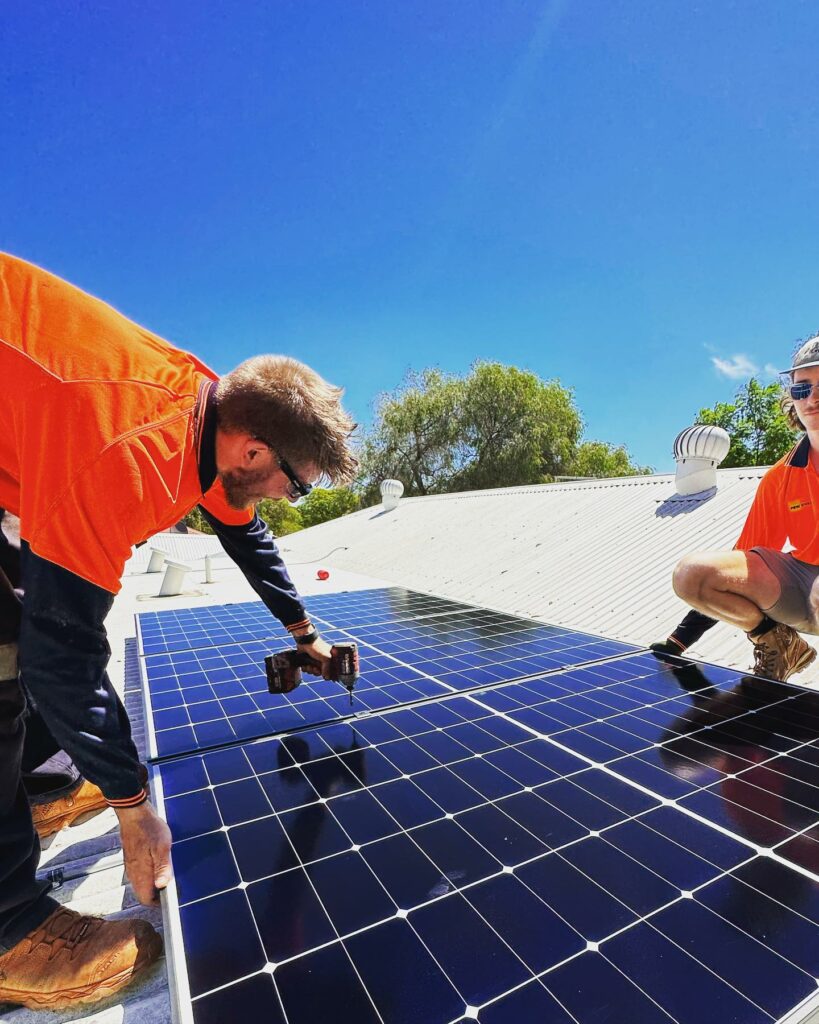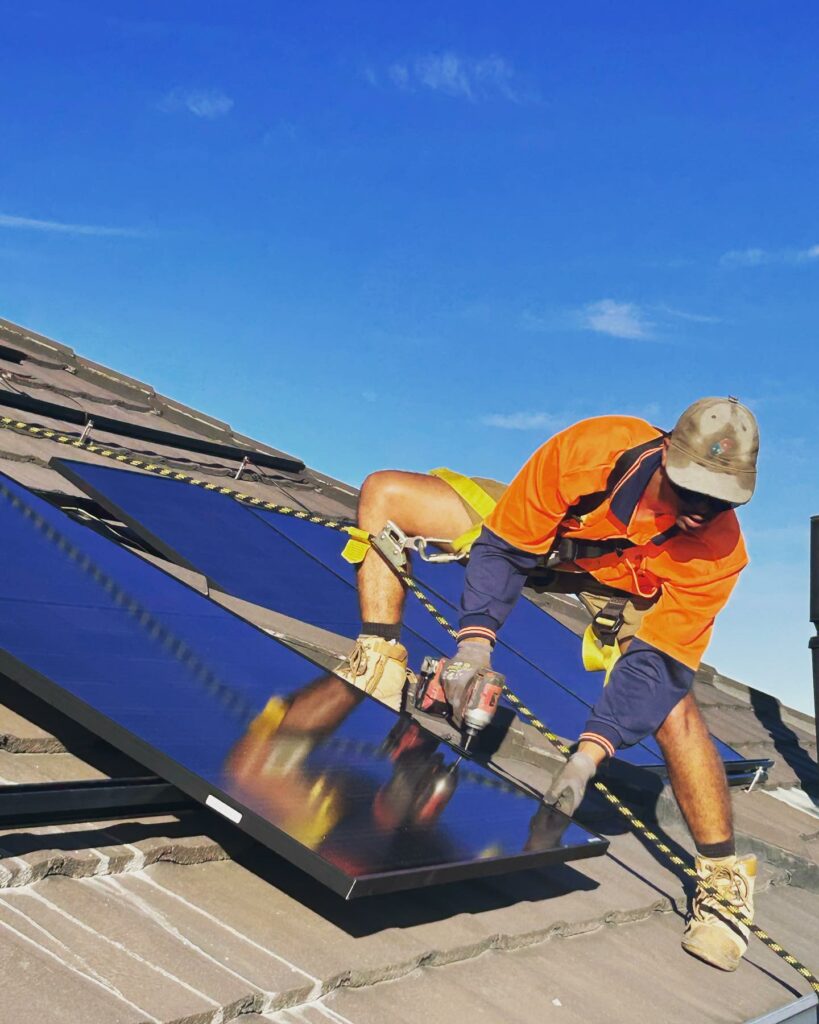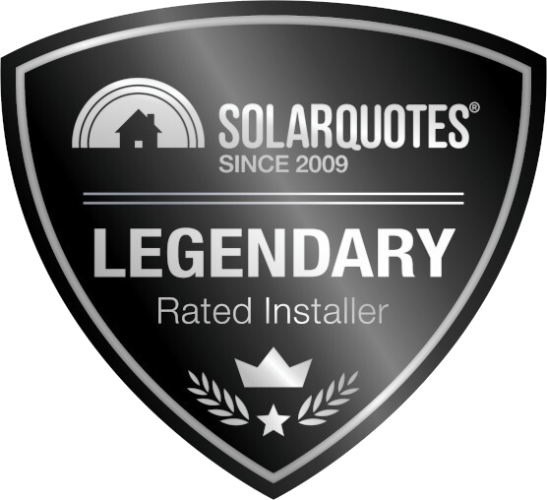Jinko’s ‘new black’ solar panel, the Jinko Tiger Neo All-Black Bifacial with Dual-Glass rolls less easily off the tongue than its monofacial predecessor—the Neo Satin series. However, this latest Jinko solar panel design is a significant upgrade to one of Australia’s favourite solar module variations, complimenting enduring performance and an even more streamlined aesthetic appeal.
Contents
Key points
- 440W : 22.02% efficiency (available), 450W : 22.52% efficiency
- Bifaciality can improve power output by up to 485W (440W model)
- High performance temperature coefficient: -0.29%/°C
- Dual-glass construction provides improved durability features over glass-laminate.
The Jinko Tiger Neo all-black bifacial is not just another solar panel; it’s a testament to Jinko’s commitment to innovation, further developing on Australia’s [and the world’s] most distributed n-type TOPCon monofacial foundation while leveraging Intersolar award-winng bifacial advancements of previous generations.
AAA-rated by PV Moduletech and BNEF Tier 1 solar panel manufacturer, Jinko Solar has consistently pushed the boundaries of what’s possible in solar technology while providing the improved bankability/brand strength investment assurance many customers seek. Jinko’s new black solar panel, the Jinko Tiger Neo all-black bifacial with dual glass, embodies this spirit, delivering unparalleled performance and value for a peace-of-mind solar panel choice.
Jinko's N-type TOPCon difference
Negative-type charged (N-type) Tunnel Oxide Passivated Contact (TOPCon) cell architecture forms the new Jinko Tiger Neo all-black bifacial foundation. Now a mainstream technology in solar panel technology across a broad range of manufacturers, Jinko has earned its title as the leader in N-Type TOPCon innovation and deployment, with over 140 GW of Jinko Neo models shipped globally in the last two years (2023,24). Further defining a global appetite for Jinko’s particular N-Type TOPCon technology.
Unlike conventional P-type (positively charged) cells, N-type cells offer superior efficiency, enhanced performance in low-light conditions, and improved high-temperature performance. This translates to more power generated throughout the day, even in Perth’s varied climate.
Tech Insight: Selecting a solar panel incorporating N-Type TOPCon technology is considered a good selection criterion for cell architecture in 2025.
Jinko Certified Installer. Receive a hassle-free express quote from Perth Solar Warehouse.
Awarded bifacial innovation
Bifaciality isn’t new—so much so that Jinko won the Intersolar Award for innovation [2019] for the earlier-generation Swan and Cheetah branded technology through progressive achievements in solar panel bifaciality. What has changed, though, is the improvements in scaled production capabilities of bifacial solar panel construction techniques as we seek to capture every available photon possible with today’s technological achievements.
Jinko’s ‘new black’ bifacial with dual glass captures sunlight from the solar panel’s front and rear surfaces. The panel has the ability to significantly boost energy production by up to 25%, utilising reflected and diffused light, improving return on investment calculations from front surface specifications.

However, the Jinko Tiger Neo all-black bifacial is a unique market option. Combining award-winning Bifacial know-how and the world’s most successful N-Type TOPCon foundations, it’s one of the most proven solar panel technology infusions of the modern era. Wherever a technology leap is involved, a track record in research, development and deployment is essential, and the new Jinko Neo all-black bifacial embodies this.
Tech Insight: Bifacial solar panel designs work best when there is a highly reflective rear surface (albedo effect). Mounted flat on the roof, all bifacial solar panels offer little additional power output, but little can multiply to become a lot when considering an extended period.
Proven. Local. More than an installer, Perth Solar Warehouse is your local expert knowledge base.
Dual-Glass endurance
Durability is paramount in the harsh Australian climate. The Jinko Tiger Neo all-black bifacial addresses this with a robust dual-glass construction, encompassing the most stable environment for a solar cell. Dual glass designs replace traditional plastic/laminate back sheets with a layer of tempered glass, creating a panel that is exceptionally resistant to damage from:
- Moisture and humidity: Preventing water ingress and corrosion.
- Extreme temperatures: Withstanding Perth’s hot summers and cooler winters.
- Mechanical stress: Providing enhanced protection against wind and hail.
- Potential Induced Degradation (PID): A phenomenon that can affect solar panel performance over time.
- UV Degradation: Ultraviolet is one of the most destructive light waves, and glass is more durable as an encapsulation material against UV light.
This dual-glass construction, incorporated within the Jinko Neo all-black bifacial, ensures long-term mechanical integrity, stabilises performance and reduces degradation potential over the solar panels’ lifespan, providing improved peace of mind.
Tech Insight: In 2025, more solar panel manufacturers will incorporate dual-glass construction techniques. However, this process requires capable engineering, superior component qualification, and precision development for the desired effect.


Aesthetics to complement your style
Beyond technology, the Jinko Tiger Neo all-black bifacial solar panel offers the opportunity to make a design statement. Sleek, all-black aesthetics seamlessly blend with any rooftop, adding a touch of sophistication to any home or business.
The Jinko Tiger Neo can’t achieve aesthetic appeal alone. It requires at least two fundamental aspects delivered complementary to the manufacturer’s intended purpose: streamlined intermediate hardware with equal warranty and a proven installation to complement the intended style.
Perth’s leading Jinko installer. Discover improved value with Perth Solar Warehouse.
Jinko Tiger Neo Bifacial specifications
The Jinko Tiger Neo series set the banechmark specifications for N-type TOPCon solar panel expectations. Considered superior to its predesecor [the Neo Satin], areas of improved specifications exist in Mechanical Specification of front and rear encapsulation defining the improved 2mm glass substrate aiding the bifacial light absorbtion.
Bifacial specifications offer a a performance boost to baseline (front surface) specifications. Performance for bifacial results is highly subjective and often less factored comparison specifications for solar arrays mounted directly to a roofs surface without tilt or low albedo.
Tech Insight: when selecting a solar panel for mounting directly to a roof surface, consider bifaciality a 1 to 5%, environment-dependent enhancement bonus when comparing monofacial solar panels of equal specifications.
Jinko Tiger Neo Bifacial datasheet
Electrical Characteristics (STC):
- Maximum Power (Pmax): 440W
- Open Circuit Voltage (Voc): 39.83 V
- Short Circuit Current (Isc): 13.98 A
- Maximum Power Voltage (Vmp): 33.44 V
- Maximum Power Current (Imp): 13.16 A
- Module Efficiency: 21.27%
- Power Tolerance: -5W ~ +15W
Mechanical Specifications:
- Dimensions: 1762 mm x 1134 mm x 30 mm
- Weight: 24.5 kg
- Cell Type: N-type monocrystalline
- Number of Cells: 108 (54×2)
- Frame: Anodised aluminum
- Front Cover: 2.0 mm glass
- Back Cover: 2.0 mm glass
- Connector: MC4-Evo2 (Staubli)
- Cable: 4.0 mm² , (+) 400 mm, (-) 200 mm
Temperature Ratings & Coefficients:
- Operating Temperature: -40°C to +70°C
- Temperature Coefficient of Pmax: -0.29%/°C
- Temperature Coefficient of Voc: -0.25%/°C
- Temperature Coefficient of Isc: 0.045%/°C
Additional Features:
- Bifacial Technology: Generates power from both sides, increasing energy yield.
- Dual Glass Design: Enhances durability and protection against harsh weather conditions.
- High Mechanical Load: Certified for 6000 Pa front and 4000 Pa rear load.
- HOT 3.0 Technology: Improves module efficiency and reliability.
- Excellent Low-Light Performance: Generates power even in cloudy or overcast conditions.
- Sleek Aesthetics: All-black design complements any architectural style.
The essential aspect
If your Jinko Tiger Neo Bifacial solar panels aren’t installed to manufacturer specifications, there is no manufacturer warranty. Ensuring a Jinko-approved installation company such as Perth Solar Warehouse improves warranty certainty.
To better ensure the product certainty you require, choose a reputable installation company with a proven operational history of enduring results to help achieve the solar panels’ promise over time.
Tech Insight: Consider the installer a system component. The installer is your local point of connection, the linking factor of critical componentry, and the responsible party for whole system warranty certainty.
Availability
The Jinko Tiger Neo Bifacial solar panel with dual-glass is available now in the greater Perth and Bunbury region of Western Australia through Perth Solar Warehouse in standard installed package sizes of 3.9, 6.6, 10, 13, and 19 kW. For commercial and industrial solar packages 30 kW and greater, we have commercial Jinko solar panel options that could be more suitable.




















